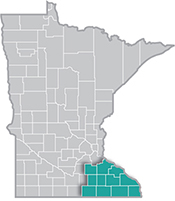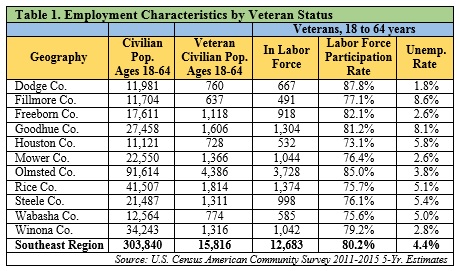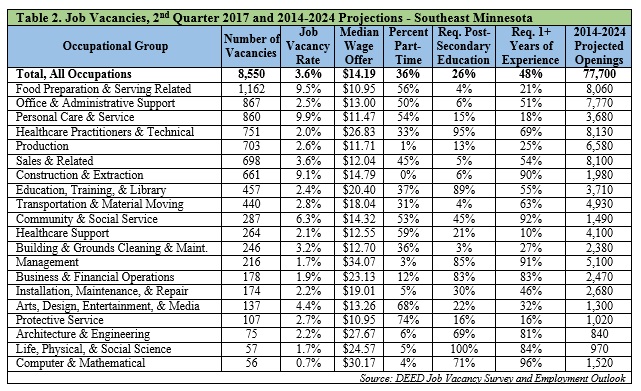 Southeast Minnesota is a health care and agricultural powerhouse. The region is home to the renowned Mayo Clinic and some of the world's most recognized food companies and brands.
Southeast Minnesota is a health care and agricultural powerhouse. The region is home to the renowned Mayo Clinic and some of the world's most recognized food companies and brands.
Advanced manufacturing is especially strong here, with machinery, chemicals, and electronics among the top products.
Want the freshest data delivered by email? Subscribe to our regional newsletters.
10/27/2017 9:47:04 AM
World War II, Vietnam, Korea, Iraqi Freedom, Enduring Freedom and New Dawn. We owe a lot to our veterans for selflessly serving our country in these – and many other – national and international conflicts. Sacrificing both their safety and time away from their homes and families, these brave men and women are a vital component to the safeguarding of the population.
For some veterans, the sacrifice goes deeper. Many veterans live with 'invisible wounds' such as post-traumatic stress disorder, mental health issues, and chemical dependency. Many others live with more apparent issues, such as service-related disabilities and homelessness. Eight percent of the homeless population in Minnesota were U.S. military veterans, according to a 2015 report by the Amherst H. Wilder Foundation.
Southeast Minnesota was home to just over 34,000 veterans, with Olmsted, Rice, and Goodhue counties being home to the highest number of vets. Many of these veterans are aging out of the labor force. However, Table 1 shows that veterans between 18 and 64 years of age still had high labor force participation rates in the 11 counties in the Southeast Region, ranging from 73 percent in Houston County to 88 percent in Dodge County. Veterans also tended to have relatively low unemployment rates in the region, with the exception of Fillmore and Goodhue counties.

Many veterans also find themselves head-to-head with employment-related roadblocks that may have a negative impact on their employment status. According to veterans employed with DEED, Scott Metcalf, disabled veteran outreach provider and Barry Platt, senior veterans employment representative, one of the big issues veterans face are low wages and a subsequent resistance to working for lower wages. "There are many veterans that have jobs but are underemployed," Metcalf said.
Current job vacancy data supports this: Many of the occupational groups with the highest number of vacancies also have low median wage offers. Five of the six occupational groups that have the most current vacancies – which account for just over half of the total vacancies in the region – have median wage offers of $13 or less (Table 2). Additionally, large percentages of these openings are part-time, meaning that in many cases, the low pay is made worse by few hours.
Those same five lower-paying occupational groups are also projected to be among the largest in regard to total hires in the region from 2014 to 2024, making up 44 percent of the total projected openings across all industries. These jobs are in high demand now and are expected to stay that way in the future.

Metcalf and Platt explain that military experience does not necessarily translate smoothly into educational equivalence. As shown in Table 2, this is an issue because higher percentages of some of the higher paying jobs require formal post-secondary education, which many veterans may be lacking. Furthermore, the number of vacancies and, in some cases, future openings, number far fewer for these higher-paying jobs that require education beyond a high school diploma.
Employers are working with veterans to accommodate successful hiring of veteran candidates. "Companies are recognizing the value of military culture, training, and credentials and accepting this as qualifications and experience toward their job openings," Platt said. Companies are beginning to recognize the skills that veterans possess, such as leadership, which makes them trainable for the positions they need filled.
More can be done to help veterans successfully gain and retain employment. "First, it would be beneficial to increase outreach to veterans organizations to heighten awareness of opportunities for employment in the area," Platt said. "Additionally, identifying veterans experiencing underemployment could better assist them with finding new or better employment opportunities."
For instance, part-time hours may not be suitable, or even desirable for a career. However, veterans faced with underemployment may benefit from the part-time hours and supplemental income those vacancies can provide. Or these vacancies can help veterans gain some work experience that would allow them to progress on their career pathway into more suitable, sustainable, and better-paying employment.
Contact Mark Schultz.